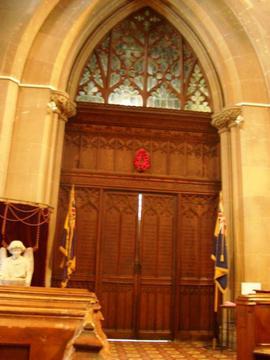
MORGAN, Thomas
| Service Number: | 2730 |
|---|---|
| Enlisted: | Not yet discovered |
| Last Rank: | Lance Corporal |
| Last Unit: | 3rd Infantry Battalion |
| Born: | New York, USA, date not yet discovered |
| Home Town: | Lidcombe, Auburn, New South Wales |
| Schooling: | Not yet discovered |
| Occupation: | Not yet discovered |
| Died: | Killed in Action, France, 24 December 1916, age not yet discovered |
| Cemetery: |
No known grave - "Known Unto God" Villers-Bretonneux Memorial, Villers-Bretonneux, Picardie, France |
| Memorials: | Australian War Memorial Roll of Honour, Villers-Bretonneux Memorial |
World War 1 Service
| 2 Nov 1915: | Involvement Private, 2730, 18th Infantry Battalion, --- :embarkation_roll: roll_number: '12' embarkation_place: Sydney embarkation_ship: HMAT Euripides embarkation_ship_number: A14 public_note: '' | |
|---|---|---|
| 2 Nov 1915: | Embarked Private, 2730, 18th Infantry Battalion, HMAT Euripides, Sydney | |
| 24 Dec 1916: | Involvement Lance Corporal, 2730, 3rd Infantry Battalion, --- :awm_ww1_roll_of_honour_import: awm_service_number: 2730 awm_unit: 3 Battalion awm_rank: Lance Corporal awm_died_date: 1916-12-24 |
Help us honour Thomas Morgan's service by contributing information, stories, and images so that they can be preserved for future generations.
Add my storyBiography contributed by Geoffrey Gillon
Thomas had been born in New York, the son of Welsh parents, John and Elizabeth Morgan, who by 1891 had moved back to their native Wales, settling eventually at Thomas Street, Pontardawe. He married Hannah Thomas, of Maesgwyn, Dyfryn Road, Alltwen, Pontardawe, Glamorgan, Wales. in 1903 and the couple had two children. Thomas worked as a bricklayer at Gilbertson’s Works in Pontardawe before emigrating to Australia prior to the war. He enlisted at Goulburn, NSW on 25 July 1915 into the 6th Reinforcements for the 18th Battalion, Australian Infantry and embarked on 2 November 1915 for Egypt. Upon arriving in Egypt he joined the Australian camp at Tel-el-Kebir and on 14 February 1916 was posted to the 3rd Battalion, Australian Infantry, which had returned to Egypt after service in Gallipoli. In March 1916, it sailed for France and the Western Front, attached to the 1st Australian Division, and familiarised itself in the Fromelles sector before being moved south to take part in the Somme offensive. The battalion's first major action in France was at Pozieres in July 1916, where Thomas was wounded in the hand. He re-joined the battalion in time to take part in the Australian attempt to capture Mouquet Farm, where they suffered terrible casualties. Later the battalion moved to Ypres, before returning to the Somme for the winter. By 23 December 1916 the 3rd AIF was in the line near Gueudecourt, carrying out repairs to their trenches and working on deep dug-outs at Grass Lane. Thomas was killed in action here by German shell-fire on 24 December 1916, aged 35. He was originally buried at the junction of trenches called Fritz’s Folly and Fatigue Alley, in map reference 57c.S.E., but his grave was lost at some time afterwards, so he is now commemorated on the Villers-Bretonneux Memorial, France.
He is honoured on the Pontardawe War Memorial.
Pontardawe is a town in the Swansea valley, which was once heavily industrialised, being in the centre of a number of coal mines, as well as tin and metal working factories, a pottery works and a brewery. As a result of this high employment, the town and its surroundings contained a high number of young men who were eager to enlist into the forces and serve their country during both World Wars.
The memorials for Pontardawe are to be found in two places.
Corner of Holly Street and Herbert Street
Pontardawe Arts Centre
Herbert Street
Pontardawe
Lliw Valley
Neath Port Talbot
SA8 4ED
Wales
The first is a four sided memorial on the corner of Herbert Street and Holly Street, with base, middle and top tier. Top tier has the Inscription, middle tier has the names of the men killed in each war. On top of the 3 tiers is an obelisk, which has a Cross carved into the West face (side facing towards the West) with a small plaque underneath, which reads “EIN GOGONEDDUS FEIRWON.” (“Our Glorious Dead”). WWI plaques are on the West face, WWII plaques are on the South face. there are 107 names listed for World War 1 and 56 names listed for World War 2. In 1985 the bronze plaque holding the inscription was replaced as it had become damaged. The memorial was originally unveiled 21st July 1923, the designer was Ernest E Morgan.
The second covers World War 1 only and takes the form of carvings in the doors of St Peter's Church, Pontardawe.
Circular single stepped base surmounted by two-stepped plinth and obelisk. Inscription on plaques attached to two sides of the pedestal. Columns support a ledge above the upper plinth. Sword of sacrifice at the top of the front face of the obelisk.











